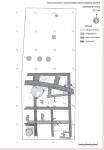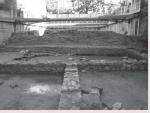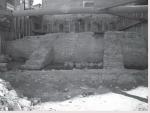Summary (English)
SERDICA (Zharin Velichkov – zharin@abv.bg) Strata of the 3rd – 6th centuries AD were explored in the northern half of the site, close to Via Diagonalis that run from Serdica to Philippopolis. The finds included c. 620 coins, jewelry (a gold earring, a small gold plate and a silver appliqué) of the 3rd century AD and a small votive lead plate showing the Danubian Horsemen. Part of the foundation of the pavement of the orchestra of the Roman theater, situated under the Late Antique amphitheater, was discovered. Walls built in opus mixtum were explored and they belonged to the orchestra, the scaena, the proskenion, the paraskenion, the postskenion and two entrances (versulae) towards the proskenion and the paraskenion. A pavement of bricks and roof-tiles was discovered in the square room located to the east of the postskenion. Bronze coins of the end of the 2nd – 3rd centuries AD were found inside the pavement, indicating the time when the theater was built. It was probably destroyed in AD 268 – 269 during the invasion of the Goths. The semicircular wall surrounding the arena of the amphitheater was explored. The wall was built in opus mixtum and was 1.30 m wide, preserved up to 1.65 m in height. It had three buttresses, 1.30 m wide, situated at 4 m from each other. The eastern jamb of an entrance towards the arena was discovered, built of bricks with a stone threshold. The amphitheater was built in the period from AD 294 to AD 320. The finds included coins, commercial and administrative seals from the end of the 2nd to the middle of the 6th centuries AD, bronze, lead and bone jewelry, terracotta lamps, fragmentary marble veneer, fragmentary glass vessels and pottery. Pottery of the 17th – 19th centuries was also found.
- Zharin Velichkov - National Institute for Immovable Cultural Heritage
Director
Team
Research Body
- National Institute for Immovable Cultural Heritage






![Download [PDF]](/excavation/skins/fasti/images/results/download_sml.png)

